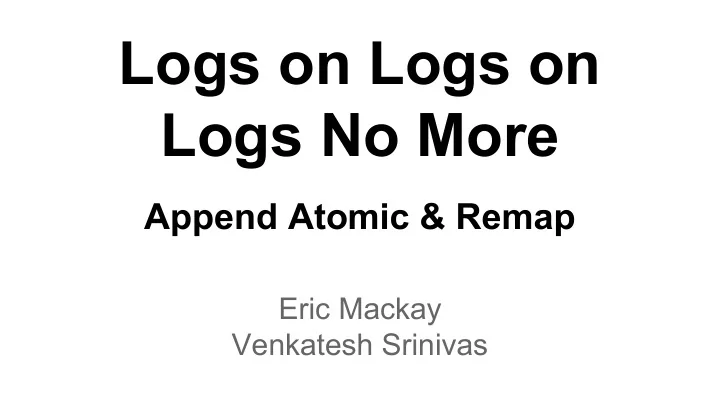

Logs on Logs on Logs No More Append Atomic & Remap Eric Mackay Venkatesh Srinivas
Basics of Block Device Interfaces ● I/O is done in granularity of blocks ○ 512 bytes is pretty standard ○ Writing is slooooooow ● Data is addressable by block number
Basics of an FTL ● Interface has access to logical block address ● Flash Translation Layer maps the logical block address to a physical block on the device ● Wear-levelling extends lifetime of device by writing new data to a different physical block and mapping the LBA to that location
Write-Ahead Logging ● To make data updates durable and consistent: ○ First write update to log ○ When update in log is durable, then write update to actual data ● If we experience a failure, consistent state can be recovered from any intermediate state
Write-Ahead Logging on an FTL ● WAL performs 2 writes for every modification to data ● Wear-levelling not done across entire disk ○ Modifying same data repeatedly will wear out some regions faster
Write Atomic & Write Scattered, Atomic ● SCSI / T10 added Write Atomic command ○ Writes data as atomic operation ○ Can only be contiguous blocks ● Databases need a scattered Write Atomic ○ Ability to write non-contiguous blocks atomically ○ Proposed but not accepted ● Some vendor-specific solutions
Append Atomic & Remap ● Write data to anonymous area of disk with Append Atomic ○ Return a token (ROD) identifying the data ○ Data not visible to anyone ● Remap the flash translation layer ○ Provide Logical Block Address and token ○ Associates LBA with the physical address corresponding to token ○ Free physical blocks that LBA used to point to ● Only intermediate state: data written but not remapped ○ Completely fine since it’s not addressable ● Also a good interface for SMR drives, not just SSDs
Append Atomic & Remap Example
Append Atomic & Remap Example
Append Atomic & Remap Example
Atomicity Across a crash cycle, RODs not preserved FTLs already support internal atomic update (for contiguous writes spanning channel / stripe boundaries) If not, FTL could double-buffer map updates
Vs. Write Scattered Pros := Deeper I/O concurrency -- overlap between flush groups is ok; Does not require all data to be available at once
Vs. Write Scattered Cons := Easy to fragment FTL tables with injudicious use of REMAP Appended-but-not-remapped data is not visible; applications need to lock associated buffers until remap is done.
Implementation details ● Built a prototype using QEMU + iSCSI target ● Maintains in-core ‘divert’ table for non-linear regions of the disk ● Accessed via vendor-specific SCSI command ● Writes diverted blocks into a ‘divert’ file.
SQLite WAL vs. SQLite Append+Remap Coming soon...
Recommend
More recommend